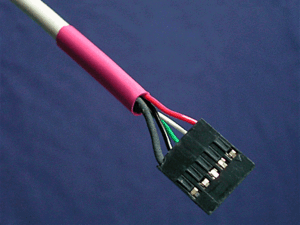Heat shrink tubing

Heat shrink tubing is useful for electrical insulation, color coding, cable bundling and mechanical protection. For electronics 1 mm (1/16") fits component leads and will shrink to a skin tight fit. Otherwise the 1/8" and 1/4" diameter sizes are often useful.[1] It is also available with adhesive inside.
Uses
To form a thermally insulating sleeve over the transistor pair and tempco in an exponential converter. Strain relief on exposed connections, e.g. leads soldered on potentiometer tags. To terminate the insulation, e.g. after the screen has been separated from the core wires and sleeved. Especially to sheath and insulate all exposed mains connections, e.g. the solder connections on a front panel mains on/off switch.
Method
Normally a heat gun is used to shrink the sleeving, taking care not to damage nearby areas and to not overheat the sleeving. The heat from a soldering iron can be used, without touching the sleeving. Do not use a direct flame. A hair dryer won't be hot enough.
Shrink ratio
The shrink ratio is the approximate maximum amount the heat shrink tubing will fully shrink compared to its unshrunk diameter. For example, a 3/4" piece with a 3:1 shrink ratio will shrink down to a maximum diameter of approximately 1/4”. Tubing with a larger shrink ratio is more forgiving in fitting, and has a bit thicker wall thickness and slightly less flexibility when shrunk than a lower ratio product.[2]
Useful sizes
To provide a degree of mechanical support for connections, e.g. to switches and jacks, a 1 cm length of 2.4mm heat-shrink will be fine for the the majority of wiring connections. For larger cables like power leads, use 6.4mm. Otherwise a small kit with short lengths of different diameter should cover.
References
- ^ Heat Shrink Tubing, JustRadios.com
- ^ How to work with heatshrink tubing..., Techflex How-Guide